Md Mostafa Kamal Mazumder, Additional Secretary (PRL), Government of the People’s Republic of Bangladesh & Ex-Secretary, Dhaka South City Corporation
Exploring the Vision, Challenges, and Achievements of Urban Governance: A Comprehensive Analysis of City Leadership in Shaping Sustainable and Inclusive Urban Futures
Urban governance is the framework through which city administrations plan, develop, and manage urban areas to ensure orderly growth and equitable service delivery. As cities become the epicenters of economic activity, culture, and innovation, their governance systems play a critical role in shaping how urban life unfolds. But with growth come mounting challenges—congestion, inequality, pollution, and infrastructural strain—making effective urban governance more essential than ever.

This article takes a deep dive into the vision, challenges, and achievements of urban governance, focusing on how city leadership across the world—including in cities like Dhaka, Comilla, Nairobi, and São Paulo—is reimagining the way urban areas are run to ensure inclusive development, resilience, and sustainability.
Understanding Urban Governance: Beyond Administration
Urban governance refers to the structures, processes, and actors involved in decision-making and service delivery in cities. It is not just about managing traffic or collecting taxes—it is about coordinating resources, engaging citizens, and creating livable spaces for all.
The key characteristics of good urban governance include:
- Accountability and transparency
- Inclusiveness and equity
- Efficiency in service delivery
- Sustainability and environmental consciousness
- Strategic and long-term planning
It requires coordination between multiple stakeholders: local governments, central agencies, private sector players, civil society, and, most importantly, the citizens.
The Vision: What Should Urban Governance Achieve?

- Sustainable Development
Cities should be planned in a way that meets the needs of the present without compromising the ability of future generations to thrive. This includes:
- Efficient land use
- Renewable energy integration
- Green public transport
- Pollution control mechanisms
- Inclusive Urban Spaces
Governance must ensure social justice by giving voice and services to the poor, women, differently-abled persons, and minorities. Affordable housing, public health services, and accessible infrastructure must be a priority.
- Technological Integration
Smart cities are not just about digital tools—they’re about data-driven decision-making. E-governance platforms, GIS mapping, automated service systems, and AI-supported urban planning are integral to modern governance.
- Civic Empowerment
Cities must be built with their citizens. Participatory budgeting, open feedback channels, and community-led initiatives are key to making governance responsive and democratic.
Real-World Challenges: The Roadblocks of Urban Governance

- Unplanned Urban Growth
Rapid rural-to-urban migration has led to the unplanned sprawl of many cities. Informal settlements, slums, and unauthorized constructions challenge service delivery and strain natural resources.
- Fragmented Institutional Roles
Often, multiple government bodies have overlapping responsibilities—leading to delays, miscommunication, and inefficiencies in service delivery. For example, road construction might fall under the city corporation, but drainage might be a national agency’s task.
- Resource Constraints
Urban local bodies often operate with limited budgets and weak revenue collection systems. Dependency on central funds limits their flexibility and responsiveness.
- Technological Gaps
In many developing countries, local governments lack the capacity and expertise to implement smart solutions. Poor internet infrastructure, lack of skilled personnel, and digital illiteracy are common barriers.
- Political Interference
Excessive political control or frequent changes in leadership often disrupt long-term planning. Projects are initiated and abandoned based on electoral cycles rather than strategic visions.

Global Achievements and Breakthroughs in Urban Governance
Despite these challenges, cities worldwide have demonstrated what visionary and people-centric governance can accomplish.
- Curitiba, Brazil – Transit-Oriented Development
Curitiba is a global model of sustainable urban planning. With its Bus Rapid Transit (BRT) system, integrated land use, and pedestrian-friendly design, the city has created a livable and efficient urban space without major external funding.
- Seoul, South Korea – E-Governance Champion
Seoul’s “Open Data Plaza” and “mVoting” app allow citizens to view city data and participate in decision-making. Real-time monitoring of services, traffic, and emergencies makes the city highly responsive and transparent.
- Ahmedabad, India – Slum Upgrading
Through the Slum Networking Project, the city collaborated with NGOs and communities to bring sanitation, electricity, and roads into slums without forced eviction. It is an example of inclusive governance that builds trust and dignity.
- Barcelona, Spain – Smart City Ecosystem
Barcelona uses sensors and digital platforms to manage everything from water consumption to parking. Its urban innovation labs engage citizens in designing new services and technologies, making them partners in progress.
The Case of Comilla City Corporation: Urban Governance in Practice

In Bangladesh, the Comilla City Corporation (CuCC) offers a practical and evolving example of urban governance rooted in service, planning, and community engagement.
Vision
CuCC’s leadership is driven by the vision of a “Smart, Clean, and Caring Comilla.” This includes:
- Expanding sustainable infrastructure
- Providing accessible civic services
- Ensuring public participation in city planning
- Creating inclusive zones for women, children, and elderly residents
Challenges
Like many mid-sized cities, Comilla faces:
- Budget limitations
- Traffic congestion and water logging
- Land management issues
- Coordination challenges with national agencies
Despite these, the Corporation has made notable progress.
Achievements

- Smart tax collection system: Citizens can now pay taxes and apply for trade licenses easily.
- Community waste management programs: Collaborating with local groups, CuCC has implemented door-to-door garbage collection and recycling awareness.
- Urban beautification and green parks: Several wards have new public parks with child-friendly and women-safe zones.
- Digital grievance redressal: A mobile app allows citizens to report issues and track solutions.
- Education support: CuCC supports public schools and has initiated digital classroom pilots in partnership with NGOs.
These efforts showcase how even smaller city corporations can innovate and grow with the right vision and civic engagement.
The Role of Citizens: From Beneficiaries to Co-Governors
A key theme in modern urban governance is the transition of citizens from passive recipients to active co-creators of their cities.
- Participatory Planning
Cities like Porto Alegre, Brazil, pioneered participatory budgeting. This model allows citizens to vote on how a portion of the city’s budget is spent, ensuring funds go where they’re most needed.
- Neighborhood Committees
Ward-level committees or block-level residents’ associations in cities like Nairobi and New Delhi have improved the accountability of local services.
- Youth Engagement
Cities are launching civic innovation labs where young people solve urban problems—whether through mobile apps, creative campaigns, or design projects.
- Social Media for Governance
Cities are using platforms like Facebook, Twitter, and WhatsApp to directly engage with citizens, announce services, and respond to queries in real-time.
Strategies for Strengthening Urban Governance
For city administrations aiming to improve their governance systems, several strategic pathways stand out:
- Fiscal Decentralization
Empowering city governments with more control over local revenues allows them to design context-specific solutions and respond swiftly to crises.
- Capacity Building
Urban governance requires skilled personnel in planning, finance, IT, and public health. Investing in training and partnering with academic institutions is key.
- Data-Driven Management
Collecting and analyzing urban data allows for better planning and monitoring. Cities should invest in GIS systems, urban dashboards, and data transparency tools.
- Strengthening Urban Legislation
City corporations need updated legal frameworks that clearly define their functions, autonomy, and coordination mechanisms with other agencies.
- Climate Resilient Planning
From green buildings and open space preservation to disaster risk reduction strategies, cities must integrate climate resilience into every planning decision.
Conclusion: Rethinking the Future of Urban Governance
Urban governance is not a static structure—it is a living process, continuously shaped by social needs, technological innovation, and environmental realities. The ultimate goal is to create cities that are not only efficient but equitable, inclusive, and resilient.
From global metropolises to growing towns like Comilla, the essence of good urban governance remains the same: putting people at the center. Visionary leadership, transparent systems, and empowered communities are the pillars that will define the cities of tomorrow.
As the world continues to urbanize, the need for collaborative, innovative, and accountable city governance is not a choice—it is a necessity. And the cities that embrace this will not only succeed in managing growth but will thrive as beacons of hope, dignity, and opportunity for millions.

